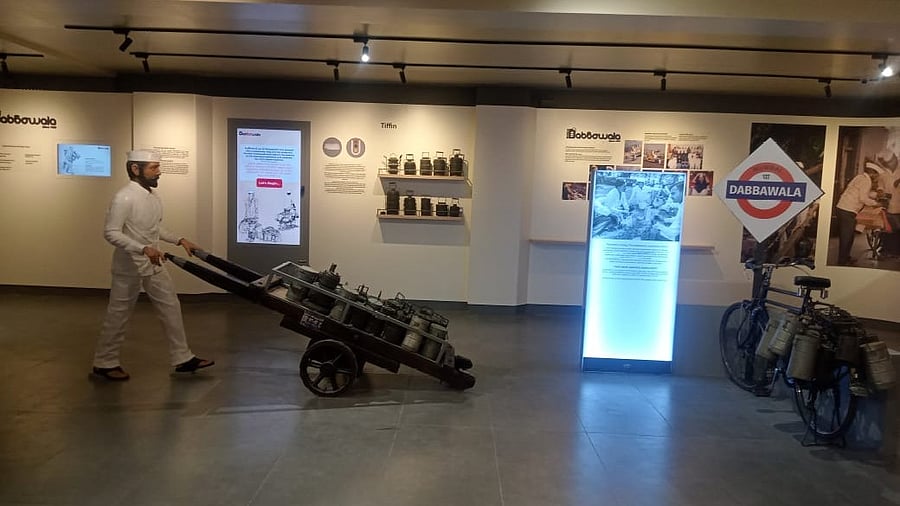
The Mumbai Dabbawala International Experience Center (MDIEC), a gallery depicting their contribution, will be inaugurated in Bandra in Mumbai.
Credit: Special Arrangement
Mumbai: Dressed in spotless white thigh-length kurta and loose pyjama outfit and donning the traditional Gandhi topi, the Dabbawalas of Mumbai are part of the story of this vibrant hustling-bustling financial capital, since 1890.
These Dabbawalas - who are now internationally known - have witnessed the transformation of Bombay to Mumbai over the past 135 years.
Now a commoner can know their complex system and how it runs.
The Mumbai Dabbawala International Experience Center (MDIEC), a gallery depicting their contribution, will be inaugurated in Bandra in Mumbai.
Today, the Dabbawalas’ numbers have dwindled sharply, from over 5,000 during the peak in 1970s-2000s ferrying over two lakh tiffin-boxes, to now barely 1,500 rushing to deliver less than a lakh lunch-boxes, post the Covid-19 pandemic.
The Dabbawalas who have developed their own unique identity code rarely misdeliever the lunch box and their service is often said to be of Six Sigma standard.
They provide healthy home-cooked food straight from the kitchen to your workplace.
The Dabbawalas area of work is the Mumbai metropolitan region (MMR) including the twin districts of Mumbai City and Mumbai Suburban and large stretches of the neighbouring districts of Palghar, Thane and Raigad.
The Mumbai Dabbawalas are an example of time management – and the accuracy of delivering dabbas (tiffin boxes) has also been an example in the IIMs, IITs and other top institutes.
The experience centre and mini museum is part of the initiative of the Nutan Mumbai Tiffin Box Suppliers Charity Trust (NMTBSCT) and Mumbai Tiffin Box Suppliers Association (MTBSA).
A few years ago, the BrihanMumbai Municipal Corporation (BMC) allotted them the space in 2022 in the Harmony Building in Bandra West.
Maharashtra Chief Minister Devendra Fadnavis will inaugurate the museum on the eve of Independence Day in presence of the closely-knit Mumbai Dabbawala community and their leaders including NMTBSCT President Ulhas Shantaram Muke and MTBSA Ramdas Baban Karvande.
At the entrance of the museum there is a portrait of founder-patriarch, the late Mahadev Havaji Bachche, who started it all in 1890.
“The coding system created by our forefathers are still prominent in 21st century. Initially it was simple colour coding but now since Mumbai is widely spread metro with three local train routes, our coding has also evolved into alpha numeric characters,” Ritesh Andre, the spokesperson Mumbai Dabbawalas, told DH on Tuesday.
“The experience centre will help a common person know about the complex-and-yet-simple sort of delivery system, which is error free,” said Andre, who hails from a fourth-generation Dabbawala family.
“The exhibition centre has displayed 10 original pieces of the tiffin-boxes as they evolved from copper to metal and now light tin-boxes, from a single-piece ‘dabba’ to a multi-layered tiffin as public needs changed over the decades, painstakingly sourced from old customers who had still preserved the defunct items,” said Andre, who is pursuing a PhD on the subject.
Credit: Special Arrangement
The Dabbawalas hail from the Khed, Maval, Junnar, Ambegaon, Mulshi and neighbouring places of Pune district - and most if them hail from Varkari sect.
The museum also adores a statute of Lord Vitthoba, the Panduranga of Pandharpur, whom the Dabbawalas worship.
The early clientele comprised mostly Parsi, Marathi, Gujarati, Marwari, Dawoodi Bohra and other Muslims working in banks, private companies, government offices, shopkeepers and others who preferred home-cooked food. In those days, the Dabbawalas mostly walked down to nearby locations pushing their tiffin boxes in handcarts, later many got bicycles for delivery. For station to station, they commute in local trains.